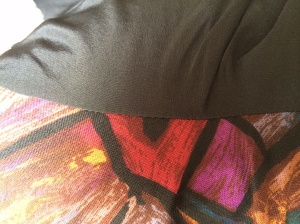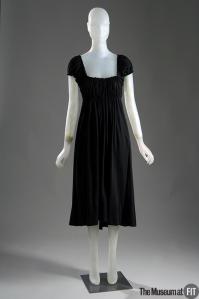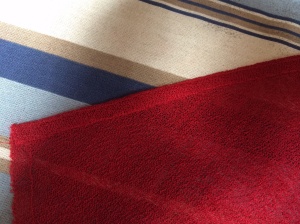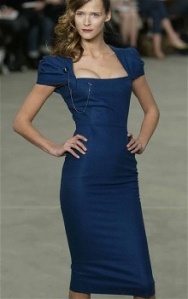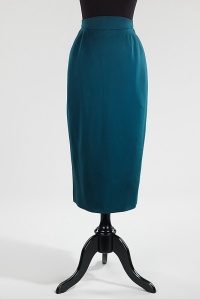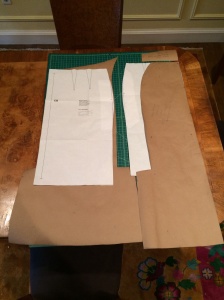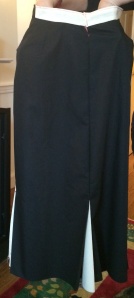Okay, I’ve had my fling with Charles James, paid homage to Madame Vionnet and gotten in a catfight with Coco Chanel. Now it’s time to give Claire McCardell her due. This red shrug is one of her designs.
As a wrap-up to all of the Charles James hyperventilation going on at Jet Set Sewing this month, some details of the completed outfit: with the 50s wool challis I used to line the kick pleats on the Charles James skirt (seen here), I made yet another version of the crushed boatneck frankenpattern I came up with this winter. (Details of that pattern are here and here). This time I made it sleeveless and lined it with silk crepe de chine ordered online from Mood.com.
Since I was getting bored with this project the third time around, I researched how to line a tank top by machine, so I wouldn’t have to hand-stitch the lining to the neckline and armholes. I’ve learned the hard way that your tank will quickly turn into a twisted mobius strip if you don’t do it right.
I decided to go with this method: rather than construct the exterior and the lining and stick them together, you sew the front piece of the fashion (exterior) fabric to the front piece of the lining, right sides together, at the armhole and neckline only. Before you stitch, fold back the lining seam allowance at the shoulder seams by 5/8″. Leave the shoulder seams, side seams, and hem unstitched.
Here’s the front of the armscye (armhole) sewn to the front of the lining armscye.
Trim the seams, clip the curves, sandwich press (press as is) then open it up and press the seam allowance toward the lining.
“Understitch” about 1/8 inch away from the seamline, on top of the lining, catching the seam allowance in the stitching.
Turn the lining under and press, a little back from the edge.
Oh yeah! Nice and clean without the dreaded topstitching.
You do the same with the back fashion fabric and lining. Then, turn both the front and back pieces right side out and stitch the shoulder seams of the fashion fabric right sides together. (You can see that the lining seam allowance is folded under so you don’t catch it in the stitching.)
Clip and press the seam you just stitched, and tuck the seam allowance inside the lining. Then slipstitch the lining together at each shoulder seam.
I wish I had a picture of the rest of the method, but I was in a hurry so of course I forgot. But basically you do the side seams one at a time, sewing the back and front fashion fabric side seam right sides together, passing the underarm seam, and then sewing the back and front lining side seam right sides together, all in one long sew. Then you do the other side the same way. Flip the whole thing right side out and do whatever hem floats your boat. I decided to hand catch-stitch up the fashion fabric hem, then slip stitch the lining over it, leaving a little room in the lining so it wouldn’t pull up the hem.
Silk crepe de chine is the best, most decadent lining, and worth every penny.
And now to my fashion girlcrush, Claire McCardell.
Though McCardell is no longer a familiar name in fashion (due to her untimely death in the late 50s), she was one of the top American designers of the 40s and 50s, and the primary inventor of the style known as the “American Look.” Her spare, sporty, architectural clothes were designed so the modern woman could move around and have a life while wearing them.
If you’ve worn any of the following items recently, you have Claire McCardell to thank for either designing or popularizing them:
ballet flats,
jersey hoodies,
wrap dresses,
peasant dresses,
fitted bathing suits,
fashion sunglasses…
The real appeal, for me, is how incredibly modern and wearable many of her designs remain.
Here’s a brief bio of Claire McCardell from “Voguepedia”: Claire McCardell bio
And a bunch of McCardell eye-candy from the Metropolitan Museum Costume Institute’s online collection: (Met Museum McCardell collection)
I’ll get into more of McCardell’s history in upcoming posts, but long story short: it was my desire to make myself a Claire McCardell that got me into this crazed vintage re-creation jag.
The shrug is taken from this 1951 Spadea pattern:
featuring one of McCardell’s famous wrap “popover” dresses, which was designed for ease of donning and wear. Since this is a halter version of the dress, the shrug covers the bare back.
Though we’re accustomed to seeing shrugs like this nowadays, this simple design was revolutionary in it’s time, as it’s made from one pattern piece (doubled) with one center back seam and two short seams under the arms creating the sleeves.
McCardell was the first American designer to use jersey to make dresses and separates, so I used lightweight wool jersey, again from Mood.com, to make the shrug.
After cutting the jersey on the bias (and giving my thumb a nice slice with those Kai shears I’m always raving about) I stabilized the seam allowances using stretch stitch #9, which gives you a seam that almost looks like a straight stitch, but still has some give:
Here’s how the stay-stitching turned out:
Where the edge would be exposed, I folded it under and stitched again to finish it:
I decided to use old school French seams to finish the interior seams, since the fabric is so lightweight.
I started out by sewing the seam wrong side together, then trimmed the seam allowances.
I pressed open the seam, turned it so the pieces were right side together, then stitched the seam again, enclosing the raw edge of the first seam.
A nice clean finish for a nice clean design.
More to come on Claire McCardell, but right now I have to start packing up my sewing projects, tools and machine to decamp for Martha’s Vineyard for the summer. I hope you’ll join me there for some stitching at the beach!


